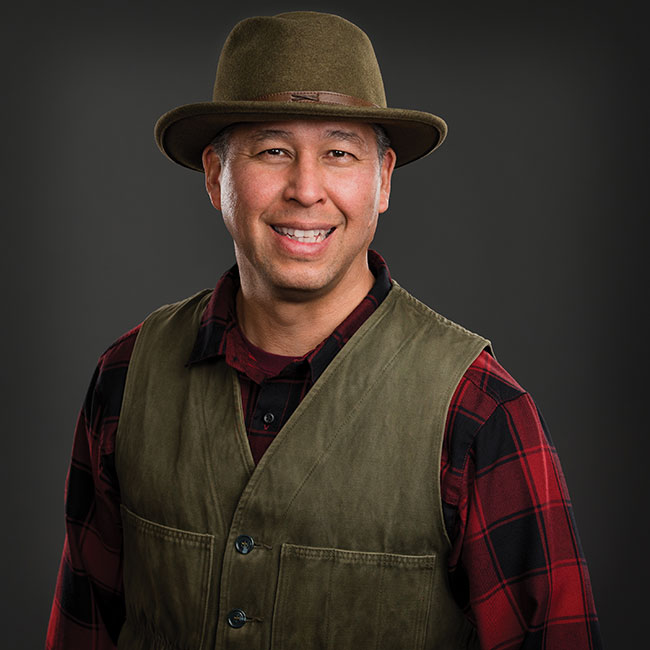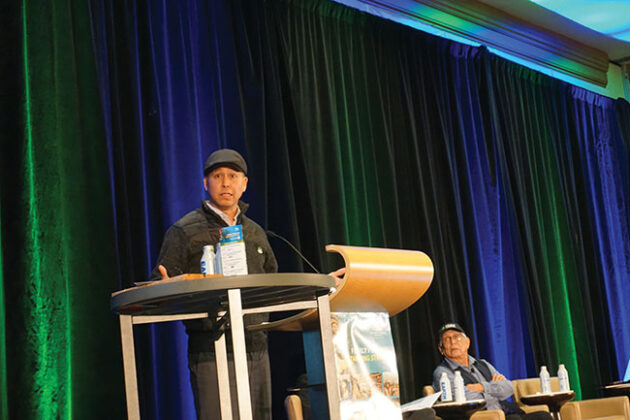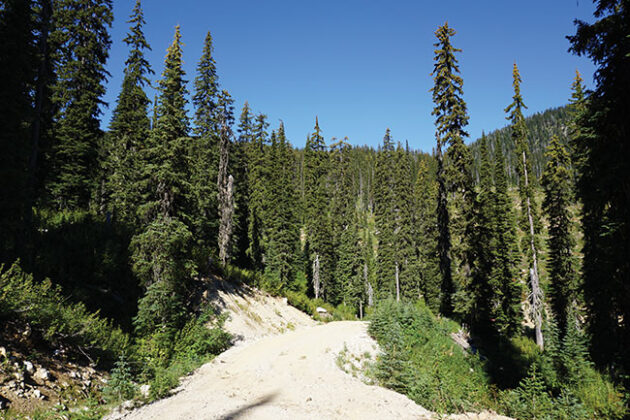
Features
Tip of the spear: Q&A with Lenny Joe
April 27, 2023 By Maria Church
 The new BCFNFC CEO likes to be called Lenny because it’s more familiar. Photo courtesy of Lenny Joe.
The new BCFNFC CEO likes to be called Lenny because it’s more familiar. Photo courtesy of Lenny Joe. Lennard Joe, the new CEO of the B.C. First Nations Forestry Council, likes to be called Lenny because it’s more familiar, and familiarity or intimacy is one of the three components of the trust equation. Trust, he says, is not just a feeling, it’s measurable.
Lenny is a registered professional forester with more than 30 years of natural resources and business experience. He is member of the Nlaka’pamux First Nation and is among the first dozen Indigenous graduates from UBC’s forestry school.
CFI sat down with Lenny to get to know him, his mission for the organization, and what Indigenous inclusion in forestry means to him.
CFI: What drew you to forestry?
I grew up on the Shackan Indian Reserve, on a ranch. I really grew up on the back of a horse – tending cattle. We grew up working hard, and we made work fun. Work was family and it was rewarding.
Without realizing it, I was learning by doing and seeing. When we’d bring salt blocks to the range, I was learning about the land, noticing the rose hips were out so the salmon will be running soon. I was immersed in that world and at the same time, I was not realizing the impacts of residential school and the impact of INAC [then called Indian and Northern Affairs Canada] at the time – government rules and regulations that were creating the world I grew up in.
My father took on the role of Chief of our community in 1971. With that he became the eighth Chief of Shackan since 1860. So we grew up exposed to the politics and it became a strong part of who I am today.
I grew up playing hockey and was pretty good. I got to the point of talking to scouts to go to university under a scholarship. Unfortunately I blew my knee and didn’t go to a U.S. university but fortunately, for me as a forester, ended up in Selkirk College for wildland recreation. It was the first time I was isolated from where I grew up. There were no First Nations at all in Castlegar, but I loved it there and excelled and learned how to learn.
Before I went to Selkirk I was a wildland firefighter, but during my years there I worked as a park ranger in the Valhallas, and I loved it. Park ranger life was great, but I started thinking about my future and going home. I started getting into wildlife and research and was working with biologists on a CP Rail project. They told me if I wanted to do what they do, I had to go to university.
I took some time to see the world and travel after Selkirk. I started realizing how small this blue planet really is and how connected things were. I realized how beautiful my territory is, and the importance and responsibility of looking after it. When I came home, I went straight in to the UBC Faculty of Forest Conservation program, it was brand new at the time.
CFI: What was your experience in university?
When I got to UBC – I think that was 1993 – I saw that there were only three First Nations people who had gone through the forestry who were registered professional foresters. I had a handful of others there with me while I was going through it.
I joined the American Indian Science and Engineering Society (AISES). I remember at an AISES meeting I said something I’ll never forget, “We’re the tip of the spear. Everything will come behind us.”
We were doing something important, and we were looking at the opportunities ahead of us. There was no real Indigenous consultation process at that time – no shared decision making. It was a very different environment. But we were becoming educated and our awareness was growing.
My first forestry summer job was with Canfor and I went up to Fort St. John to work on a biodiversity study. I had a certain amount of plots to take measurements and data. I finished everything they had assigned early so they put me into the layout and development crew. That’s when I realized that the biggest impact to our land was the forest industry. I knew at that moment it was very important to do that right.
That’s when I changed my career path. I stayed with the conservation program, but started taking the extra courses to become a registered professional forester – to make some changes.
I liked what I learned up in Fort St. John, but I didn’t like that I was working on someone else’s traditional territory and didn’t have a strong relationship with them, and I was homesick. The next summer, I got a job with Weyerhaeuser and I got to work at home.
During my time in Merritt, our tribal council was working to create an effective referral process and access to forest tenures. The Chiefs asked me to layout an [illegal] block for them off reserve land so they could build a portable mill and make lumber for a houring project, and I agreed. There I was, laying out this block, thinking I just invested how many years into becoming a RPF and I may never become one because I am now taking civil disobedience to a whole new level. We never ended up harvesting that block and worked out an agreement with the province to access a non-replaceable forest license on behalf of the Nicola Bands. West Bank First Nation had also laid out and logged a block, gone to court and won. Now we were having discussions with the provincial government and creating a foothold in forestry.

Lenny Joe (left) and Chief Robert Dennis of the Huu-ay-aht First Nation at the 2023 Truck Loggers Association convention in Vancouver, B.C. Photo: Annex Business Media.
CFI: Where did your career take you after you became and RPF?
I told Weyerhaeuser during an interview that I would work for them for a few years, and then I wanted to start my own consultant business because what I wanted to do wasn’t invented yet and that was what I called First Nations forestry. When I started Grizzly-Man Resource Management, one of the first things that we had access to was woodlots. I had contracts to develop and harvest about 16 different woodlots, and at the same time continued to work closely with Weyerhaeuser and continued to build our relationship.
During this time, the Indigenous world was waking up to this industry and really becoming more and more involved. We started recognizing that we needed measurables for our values. Our food security and our very existence meant that we had to learn how to quantify and create these measurables.
Over the last 30 years, we’ve been developing mutual trust. That’s what I value a lot. I work with the trust equation. Like everything, it’s measurable, it’s not just a feeling. Trust is credibility plus reliability plus intimacy, divided by self-orientation. How credible are they? How reliable are they? How intimate are they? And that self-orientation is about how much they’re doing it for themselves versus for us.
CFI: Where do you see Indigenous participation levels at now?
My grandfather always used to say, “Look after your house, know who your guests are and treat them well. But don’t let them move the furniture.” That’s our responsibility, really. Over the years, we looked after our house, we treated our guests well, but a lot of our furniture has moved.
Then UNDRIP [UN Declaration on the Rights of Indigenous Peoples] came and it’s really a declaration for when laws aren’t there yet. And B.C. took that very seriously – they passed legislation [Declaration on the Rights of Indigenous Peoples Act – DRIPA]. So now, all past, present and future laws in B.C. must have the intent of UNDRIP.
But now we have to understand and take on that responsibility. We really need those relationships and that trust now. And for everyone to come to the tables to do the work that needs to be done.
For years we’ve had to fight for the rights, but now First Nations are in an environment of responsibility. Now we’re looking after our house, and we need to still treat our guests well. They live in adjacent communities. Our house has evolved into a modern world.
I’m conditioned to be a very good forester. My grandfather used to say, if we’re going to survive, we’re going to have to think like a white man. What I think he meant is that we need to know what they’re thinking. I’ll say it lightly, but I think I’m pretty good thinking like a white man! I went to the schools. I was immersed in it. But thank goodness I’ve held onto enough of where I come from. Now I say to non-First Nations, for you to survive, you have the learn to think like an Indigenous person. It will take a lot of work. But when we do come together, I think it will be very unique and I think globally it will be reflective of who we are as British Columbians.

“Forestry is very important to us. It’s in our backyard. It creates employment. And we want healthy workplaces to create healthy people, families and they create healthy communities.” Photo: Annex Business Media.
CFI: As the new CEO of the B.C. First Nations Forestry Council as of last August, what are your goals in the role?
Forestry is very important to us. It’s in our backyard. It creates employment. And we want healthy workplaces to create healthy people, families and they create healthy communities. I think that’s everybody’s goal.
It will be really interesting with the role that I play with the B.C. First Nations Forestry Council, to help create that environment so that we can move forward in a healthy way to create healthy communities, look after our house, the land, water, foods and medicines, and that really is reflective of us as British Columbians.
We don’t speak for the 200 plus bands, but we are working to create that environment and space for effective government-to-government dialogue.
Another very important goal is to increase our First Nations youth to take on the responsibility to be stewards of the land. To build capacity. We want 2,000 to 2,500 Indigenous youth to come into the forest industry in the next 10 years.
CFI: What do you see as the biggest challenge and biggest opportunities for First Nations players in the B.C. forest sector?
Where I see us going is that we will, for the first time, start incorporating our knowledge, our values, our ways, into legislation and laws. We are now moving the goal posts. For the first time in history, non-First Nations laws will truly reflect everybody.
Our roots stayed intact and they were deep enough to come back. But now we as Indigenous peoples need to reflect on what we’ve been conditioned to believe and what is the true natural laws of where we come from. That will take time, capacity and work.
There is a capacity issue. Forestry is just one facet of everything that’s happening with reconciliation and DRIPA. There’s only so much capacity in First Nations communities. If we are going to incorporate who we are and what we are into forestry, we need to fill rooms and that’s going to take non-First Nations to be a part of that. It’s going to take us all.
We have to get into those rooms with mutual trust and respect. Carbon and climate change and the effects of that are threatening and pressuring all of us. But I’m optimistic in that sense, and I have to be. Our very world depends on that.
There’s a long way to go, but I don’t think it will take as long as we think. It will just take the right people.
Print this page